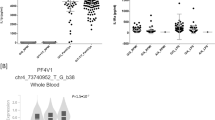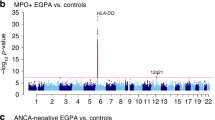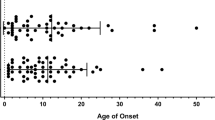Abstract
We have investigated the hypothesis that constitutional genetic variation in IL-5 signalling may be associated with the development or severity of FIP1L1–PDGFRA-positive chronic eosinophilic leukaemia (CEL) in humans. We genotyped six single-nucleotide polymorphisms (SNP) within or close to the IL5RA or IL5 genes in 82 patients with FIP1L1–PDGFRA-positive CEL plus, as controls, healthy individuals (n=100), patients with FIP1L1–PDGFRA-negative eosinophilia (n=100) or patients with chronic myeloid leukaemia (CML) (n=100). We found no association between SNP allele frequency between FIP1L1–PDGFRA-positive and control cases. However, for FIP1L1–PDGFRA cases, we found an association between the genotype at rs4054760, an SNP in the 5′-UTR of IL5RA and peripheral blood eosinophil count (P=0.026) as well as the presence or absence of tissue infiltration (P=0.032). Although these associations fell below the level of significance once corrected for multiple testing, no such association was seen in FIP1L1–PDGFRA-negative cases and no difference in allele frequencies for rs4054760 was seen in control populations across Europe. Furthermore, in an analysis of 112 patients with CML, IL5RA expression was strongly related to rs4054760 genotype (P<0.001). These data suggest that the variations in IL5RA expression are linked to constitutional IL5RA genotype and severity of FIP1L1–PDGFRA disease.
This is a preview of subscription content, access via your institution
Access options
Subscribe to this journal
Receive 12 print issues and online access
$259.00 per year
only $21.58 per issue
Buy this article
- Purchase on Springer Link
- Instant access to full article PDF
Prices may be subject to local taxes which are calculated during checkout

Similar content being viewed by others
References
Vardiman JW, Harris NL, Brunning RD . The World Health Organization (WHO) classification of the myeloid neoplasms. Blood 2002; 100: 2292–2302.
Cools J, DeAngelo DJ, Gotlib J, Stover EH, Legare RD, Cortes J et al. A tyrosine kinase created by fusion of the PDGFRA and FIP1L1 genes as a therapeutic target of imatinib in idiopathic hypereosinophilic syndrome. N Engl J Med 2003; 348: 1201–1214.
Roche-Lestienne C, Lepers S, Soenen-Cornu V, Kahn J-E, Lai J-L, Hachulla E et al. Molecular characterization of the idiopathic hypereosinophilic syndrome (HES) in 35 French patients with normal conventional cytogenetics. Leukemia 2005; 19: 792–798.
Pardanani A, Ketterling RP, Li CY, Patnaik MM, Wolanskyj AP, Elliot MA et al. FIP1L1–PDGFRA in eosinophilic disorders: prevalence in routine clinical practice, long-term experience with imatinib therapy, and a critical review of the literature. Leuk Res 2006; 30: 965–970.
Jovanovic J, Score J, Waghorn K, Dilloni D, Gottardi E, Metzgeroth G et al. Low-dose imatinib mesylate leads to rapid induction of major molecular responses and achievement of complete molecular remission in FIP1L1–PDGFRA positive chronic eosinophilic leukaemia. Blood, 2007; 109: 4635–4640.
Cools J, Stover EH, Boulton CL, Gotlib J, Legare RD, Amaral SM et al. PKC412 overcomes resistance to imatinib in a murine model of FIP1L1–PDGFRalpha-induced myeloproliferative disease. Cancer Cell 2003; 3: 459–469.
Yamada Y, Rothenberg ME, Lee AW, Akei HS, Brandt EB, Williams DA et al. The FIP1L1–PDGFRA fusion gene cooperates with IL-5 to induce murine hypereosinophilic syndrome (HES)/chronic eosinophilic leukaemia (CEL)-like disease. Blood 2006; 107: 4071–4079.
Cheong HS, Kim LH, Park BL, Choi YH, Park HS, Hong SJ et al. Association analysis of interleukin 5 receptor alpha subunit (IL5RA) polymorphisms and asthma. J Hum Genet 2005; 50: 628–634.
Ryan AW, Thornton JM, Brophy K, Daly JS, McLoughlin RM, O'Morain C et al. Chromosome 5q candidate genes in coeliac disease: genetic variation at IL4, IL5, IL9, IL13, IL17B and NR3C1. Tissue Antigens 2005; 65: 150–155.
Yamamoto N, Sugiura H, Tananka K, Uehara M . Heterogeneity of interleukin 5 genetic background in atopic dermatitis patients: significant difference between those with blood eosinophilia and normal eosinophil levels. J Dermatol Sci 2003; 33: 121–126.
Kouriba B, Chevillard C, Bream JH, Argiro L, Dessein H, Arnaud V et al. Analysis of the 5q31–q33 locus shows an association between IL13-1055C/T IL-13-591A/G polymorphisms and Schistosoma haematobium infections. J Immunol 2005; 174: 6274–6281.
Choi EH, Lee HJ, Yoo T, Chanock SJ . A common haplotype of interleukin-4 gene IL4 is associated with severe respiratory syncytial virus disease in Korean children. J Infect Dis 2002; 186: 1207–1211.
van Dongen JJM, Langerak AW, Bruggemann M, Evans PA, Hummel M, Lavender FL et al. Design and standardization of PCR primers and protocols for detection of clonal immunoglobulin and T-cell receptor gene recombinations in suspect of lymphoproliferations: report of the BIOMED-2 Concerted Action BMH-CT98-3936. Leukemia 2003; 17: 2257–2317.
White HE, Durston VJ, Seller A, Fratter C, Harvey JF, Cross NCP . Accurate detection and quantitation of heteroplasmic mitochondrial point mutations by pyrosequencing. Genet Test 2005; 9: 190–199.
Cross NCP, Melo JV, Feng L, Goldman JM . An optimized multiplex polymerase chain reaction (PCR) for detection of BCR–ABL fusion mRNAs in haematological disorders. Leukemia 1994; 8: 186–189.
Gabert J, Beillard E, van der Velden VH, Bi W, Grimwade D, Pallisgaard N et al. Standardization and quality control studies of ‘real-time’ quantitative reverse transcriptase polymerase chain reaction of fusion gene transcripts for residual disease detection in leukemia—a Europe Against Cancer program. Leukemia 2003; 17: 2318–2357.
Livak KJ, Schmittgen TD . Analysis of relative gene expression data using real-time quantitative PCR and the 2(-Delta Delta C(T)) method. Methods 2001; 25: 402–408.
Acknowledgements
SB, SK, KW and HW designed and performed the laboratory analysis; CP, KZ, CZ, DC, FBB, CW, GM and AR provided patient samples and data; NC designed and directed the study. All authors reviewed and commented on the manuscript. This work was supported by the Forschungsfoerderungsverein der Krebshilfe Oberoesterreich, Leukaemia Research (UK), the Lady Tata Memorial Trust and the ‘European LeukemiaNet’ within the 6th European Community Framework Programme for Research and Technological Development.
Author information
Authors and Affiliations
Corresponding author
Rights and permissions
About this article
Cite this article
Burgstaller, S., Kreil, S., Waghorn, K. et al. The severity of FIP1L1–PDGFRA-positive chronic eosinophilic leukaemia is associated with polymorphic variation at the IL5RA locus. Leukemia 21, 2428–2432 (2007). https://doi.org/10.1038/sj.leu.2404977
Received:
Revised:
Accepted:
Published:
Issue Date:
DOI: https://doi.org/10.1038/sj.leu.2404977
Keywords
This article is cited by
-
Five years since the discovery of FIP1L1–PDGFRA: what we have learned about the fusion and other molecularly defined eosinophilias
Leukemia (2008)
-
Novel gain-of-function mutation in the extracellular domain of the PDGFRA gene in infant acute lymphoblastic leukemia with t(4;11)(q21;q23)
Leukemia (2008)



